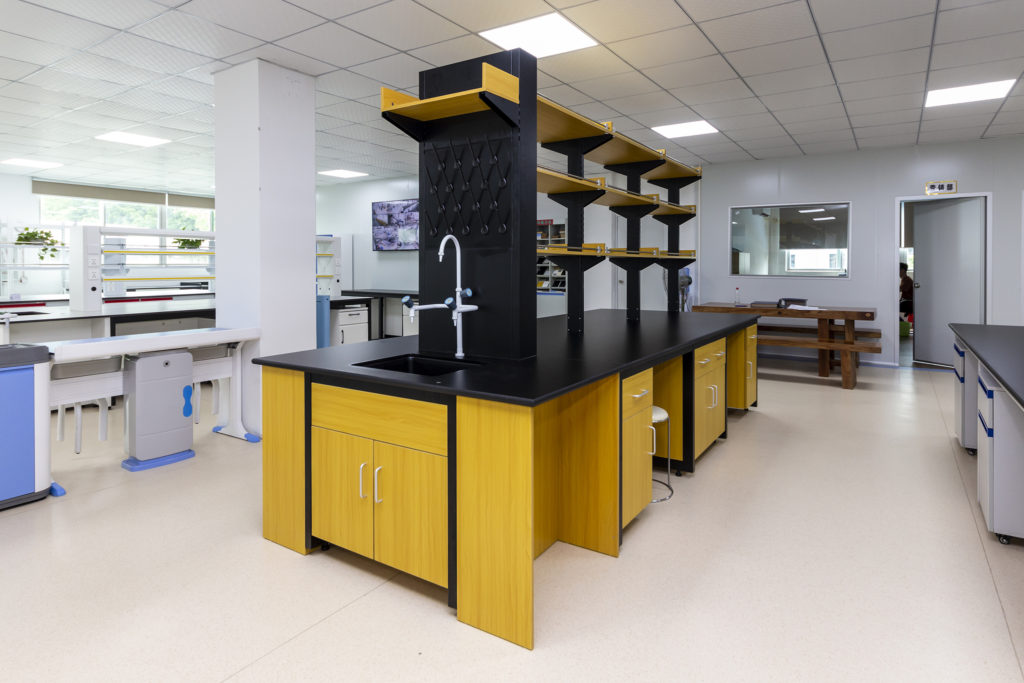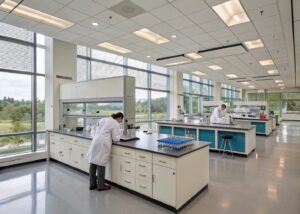Table of Contents
Building a lab is an intricate and expensive undertaking. From architectural design to lab-specific furniture and equipment, costs can escalate quickly if not managed effectively. As an expert in laboratory construction, I’ve encountered many lab projects where careful planning made the difference between a financially manageable build and a budgetary nightmare. In this article, I’ll share strategies to help you control lab building costs while maintaining high standards of safety and functionality.
Start with a Detailed Project Plan
A well-documented project plan is the foundation of cost control. Before any construction begins, ensure your project plan outlines:
- Design requirements: Understand the specific needs of your lab. Will it be a research lab, a teaching facility, or a clinical lab? Each lab type has unique requirements, from airflow systems to furniture design.
- Space needs: Carefully calculate how much space you need, as unused or excessive square footage can drive up costs.
- Regulatory compliance: Be aware of the relevant building codes and safety regulations, such as fire safety, chemical storage, and ventilation systems. Compliance oversights can lead to costly delays and modifications later.
Thorough planning upfront can help avoid budget overruns and unnecessary changes down the line.
Prioritize Flexibility with Modular Design
A growing trend in laboratory construction is the use of modular designs. These systems offer a flexible approach to lab layout, allowing spaces to be reconfigured based on future needs. Modular lab furniture, such as mobile benches and adjustable casework, not only saves on upfront costs but also minimizes future renovation expenses.
By incorporating modular elements, you can reduce long-term building costs as the lab’s purpose evolves, avoiding expensive redesigns in the future.
Invest in High-Quality Materials for Long-Term Savings
While it may seem counterintuitive, investing in high-quality materials during construction can save money in the long run. Durable lab furniture, corrosion-resistant surfaces, and heavy-duty equipment are essential for the longevity of a laboratory. Opting for cheaper materials might save money initially, but frequent replacements and repairs can quickly eat into your budget.
For instance, stainless steel workbenches and phenolic resin countertops are pricier upfront, but their resistance to chemicals and heat means they’ll last much longer than less expensive alternatives, reducing maintenance costs.
Smart HVAC Design for Energy Efficiency
Lab environments have stringent climate control needs, and heating, ventilation, and air conditioning (HVAC) systems often account for a significant portion of energy costs. To manage your lab’s HVAC expenses:
- Design with efficiency in mind: Work with HVAC professionals to design systems that meet lab specifications while optimizing energy usage.
- Use Variable Air Volume (VAV) fume hoods: These hoods adjust airflow based on the number of active users, helping to control energy consumption without compromising safety.
By optimizing the HVAC design, you’ll reduce operational costs and help your lab maintain a lower carbon footprint over time.
Evaluate Cost-Saving Opportunities for Specialized Equipment
Labs require specialized equipment that often comes with a high price tag. However, you can find opportunities to save:
- Buy used or refurbished equipment: Some lab instruments can be purchased secondhand, offering significant savings without compromising on quality.
- Opt for multi-functional equipment: Instead of buying several single-purpose tools, consider multi-functional machines that can handle a variety of tasks.
- Negotiate with suppliers: Establish relationships with lab furniture and equipment suppliers to secure bulk discounts or long-term partnership deals.
Strategically planning equipment purchases will reduce both initial costs and future replacement expenses.
Hire an Experienced Laboratory Contractor
Choosing the right contractor is crucial to controlling lab building costs. An experienced laboratory contractor understands the specific challenges of lab construction, including specialized HVAC systems, chemical-resistant materials, and precise design needs. They can also anticipate potential regulatory issues, helping to avoid costly changes or penalties later in the process.
Vet your contractors carefully. Look for those with proven experience in lab building and request detailed cost estimates before committing to any agreements.
Optimize Construction Phases to Reduce Downtime
Whether you’re building a new lab or renovating an existing one, timing is key. Optimizing the construction phases to reduce downtime is an effective cost-control strategy. If you’re managing a renovation, a phased approach can keep sections of your lab operational while other areas are under construction.
Collaborate closely with your project team to develop a schedule that minimizes lab downtime and prevents unnecessary labor costs from escalating due to delays.
Future-Proof Your Lab for Expansion
Future-proofing is an often-overlooked aspect of laboratory building. By designing a lab that can grow and adapt to future technologies and needs, you’ll avoid expensive renovations. Some considerations include:
- Scalable infrastructure: Incorporate flexible wiring, data systems, and plumbing that can handle additional equipment and future upgrades.
- Expandable layouts: Create layouts that can accommodate additional lab benches, fume hoods, or storage solutions without major structural changes.
Conclusion
Controlling lab building costs is a matter of smart planning, strategic investment, and collaboration with experienced professionals. By prioritizing modular designs, choosing quality materials, and optimizing your construction processes, you’ll be able to build a functional, future-proof lab without breaking the bank.
Remember, an upfront investment in key areas like HVAC systems, lab furniture, and equipment can save you significant money over the lifetime of your lab.
If you’re preparing for a lab construction project and need expert advice, contact a laboratory construction professional to help guide you through the process while keeping your budget in check.




